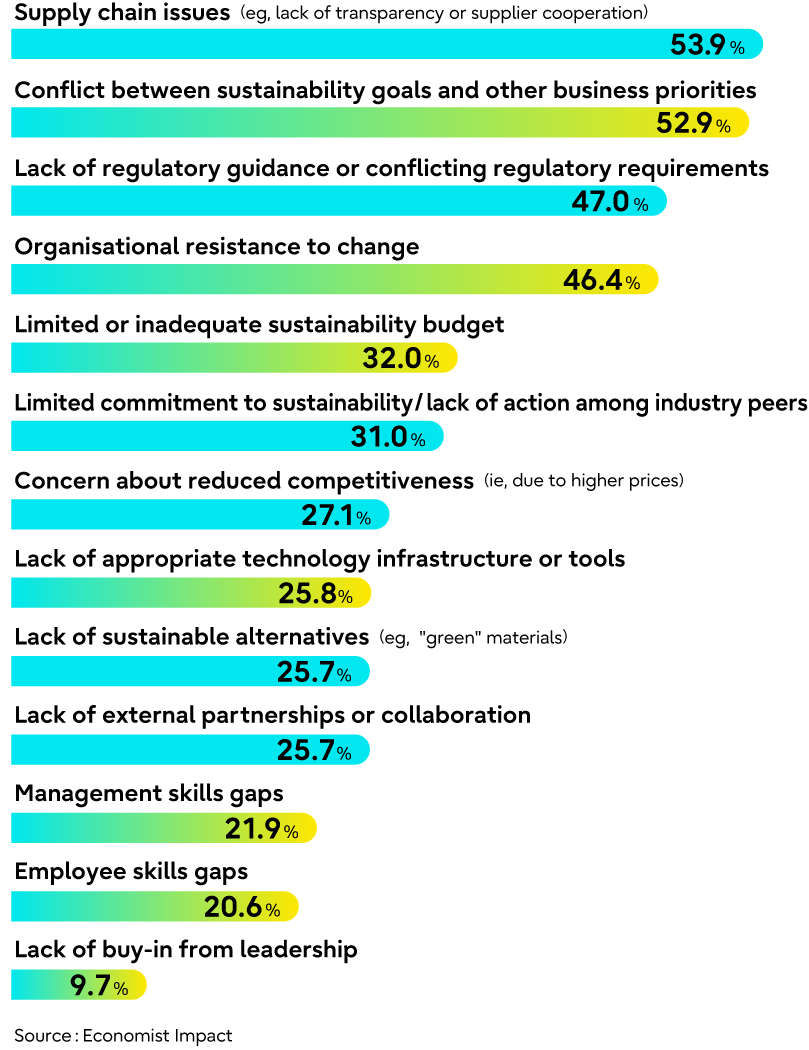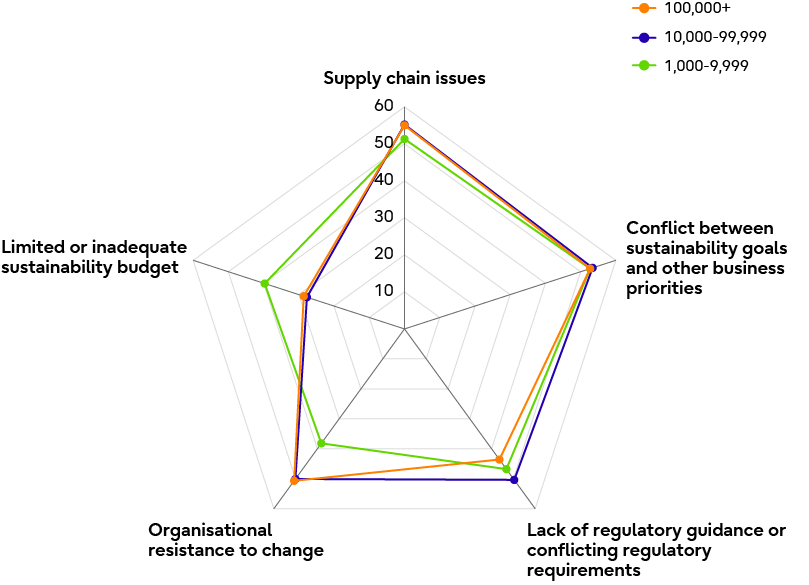Overcoming the company size dilemma: A roadmap for sustainable business transformation

Article | 2025-9-4
10 minute read
A survey by the Economist Impact uncovers the "company size dilemma" hindering promotion of Net Positive. This article dives deep into practical solutions for overcoming large enterprises' resistance to change and SMEs' budget constraints, paving the way for sustainable business growth.
What is Net Positive?
Net Positive is a transformative business concept. It moves beyond simply minimizing negative impacts. Instead, it actively seeks to generate positive value for society and the environment through corporate activities.
A comprehensive index on Net Positive was developed by the Economist Impact. It explored how companies in 17 countries across five key industries (financial services, manufacturing, transportation, retail, and energy & social infrastructure) are embracing Net Positive initiatives.
The core findings and insights from the survey are detailed in the "The Net Positive Index: Executive Summary." This article specifically analyzes data from 1,800 CxOs and decision-makers, examining the critical factors that impede the achievement of Net Positive goals.
Net Positive challenges: Large enterprises face change resistance, SMEs struggle with budget
The research found that those businesses that achieve on Net Positive are more successful. But many more struggle to implement their Net Positive strategies. Why is this? The survey by the Economist Impact provides crucial answers. As highlighted in our previous article, "What is Net Positive? Key Barriers and How Companies Can Overcome Them," a significant organizational barrier is "resistance to change." A striking 46.4% of CxOs and decision-makers identified this as a major hurdle (Table 1).

Notably, "organizational resistance to change" varies significantly based on company size. Our data reveals that larger enterprises are more likely to encounter this as a barrier (Figure 1). For instance, 55.0% of companies with 100,000 or more employees reported this challenge, compared to just 38.2% of companies with 1,000 to 9,999 employees.

For large corporations, the considerable time and human resources required to drive significant change act as a brake on Net Positive progress. Complex hierarchical structures and intricate stakeholder coordination often become major obstacles. Conversely, while small and medium-sized enterprises (SMEs) typically possess greater organizational flexibility, they face a fundamental challenge: budget constraints.
Further analysis of Figure 1's company-size-specific challenges clearly shows that budget limitations are a more prominent barrier for smaller companies in their Net Positive journey. While only 28.6% of companies with 100,000 employees cited budget as a challenge, this figure climbed to 39.7% for companies with 1,000 to 9,999 employees.
Disconnections between "agility" and "investment capacity" defines the core of the "company size dilemma" in Net Positive adoption.
Building a Net Positive ecosystem: Collaborative strategies to overcome the company size dilemma
Large enterprises often possess the budget but are hindered by internal change resistance in their pursuit of Net Positive. Conversely, smaller enterprises, while more agile, face significant budget limitations. A powerful solution to this dilemma lies in fostering stronger collaboration between large and small companies. Large enterprises can learn valuable lessons from smaller companies regarding organizational agility and employee mindset shifts for Net Positive promotion, using them as models for internal reform. SMEs, in turn, can actively seek partnerships with larger enterprises whose purpose and values align, collectively building an ecosystem to drive Net Positive initiatives. A single company's impact is inherently limited. For a lot companies, they encounter barriers in achieving Net Positive. Therefore, we have provided some actions you can take to help achieve it.
Actionable steps for Net Positive: First moves for businesses (by company size)
▶ First actions for large enterprises: How can large companies engage with smaller companies?
For large enterprises, "resistance to change" is a significant hurdle to Net Positive implementation. Overcoming this requires sharing the fundamental importance of Net Positive across the entire organization and building momentum by including smaller, agile, innovative players in your ecosystem.
1. Strong leadership & top management commitment:
● CEOs and executives must position Net Positive initiatives as a top strategic priority. Clear, consistent messaging, both internally and externally, will inspire employee mindset shifts and motivate organizational transformation.
2. Employee engagement & awareness:
● Conduct targeted workshops and educational sessions to share the core concepts of Net Positive and showcase successful case studies, raising individual employee awareness and buy-in.
3. Cross-departmental collaboration:
● To identify and address the root causes of change resistance, create opportunities for cross-departmental dialogue. This fosters a collaborative environment and encourages mindset transformation.
● Share early successes to reduce organizational friction and provide a blueprint for broader adoption across other departments.
▶ First actions for SMEs: Proactive information gathering & external partnerships
For SMEs, budget and resource constraints often pose challenges for Net Positive adoption. However, by leveraging external partnerships and existing support systems, they can take meaningful steps forward.
1. Comprehensive information gathering:
● Invite companies and experts leading Net Positive initiatives to conduct seminars. This provides valuable opportunities for executives and employees to deepen their knowledge and understanding.
2. Exploring supply chain collaboration:
● Harness the inherent speed of decision-making and operational flexibility within SMEs. Strengthen partnerships with existing large enterprise clients who are actively seeking supply chain transformation through Net Positive.
3. Understanding & analyzing importance of Net Positive:
● As a company, clearly define why "Net Positive" is crucial for your business. Transparently disclose your initiatives to enhance external communication and reputation.
● Conduct a competitive analysis to understand your current standing and identify priority areas for Net Positive action.
Net Positive journey: Clarify challenges, define your next steps
You can find out how Net Positive your company is in only a few minutes, by using the Net Positive Assessment tool. Independently researched and developed by Economist Impact, it provides businesses with a clear visualization of their current position and specific challenges on the path to Net Positive. This tool helps you understand your relative standing within your industry and offers multi-faceted insights to prioritize actionable steps. Use this tool to pinpoint where your company currently stands and confidently take the next transformative step towards a Net Positive future.
Michiyo Hano
Manager,
Global Marketing Unit, Marketing Strategy division, Corporate Insights team, Fujitsu Limited
Joined Fujitsu in October 2023
after working as a reporter for Nikkei BP, ZDNet and ASCII, editor in chief of MSN Japan and social media marketing lead for Microsoft Japan.

Are you Net Positive ready?
Discover how your organization is advancing toward a thriving, Net Positive future.


Related Information
Advancing Net Positive - Driving Profit with Purpose


Key Barriers and How Companies Can Overcome Them

